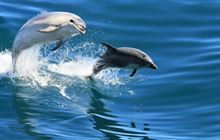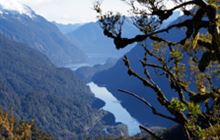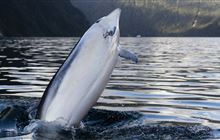Doubtful Sound bottlenose dolphins
Introduction
Learn about the bottlenose dolphins in Fiordland’s Doubtful Sound/Patea and how you can help to protect them.What's the issue?
The bottlenose dolphins found in Fiordland’s Doubtful Sound/Patea form a small resident population living at one of the southernmost locations in the world for this species.
Research has shown that this population has decreased by at least a third since 1994, with the latest estimate in 2008 at 56 dolphins. This rate of decline is not sustainable for such a small population.
The causes behind the decline are not well understood but may include human-related effects such as vessel activity and habitat modification. To help minimise the potential impact of vessel activity on the dolphins, a new set of protection measures were introduced in 2008, and are outlined in the Doubtful Sound marine mammal code of management.
What's being done?
As an extra level of protection to the Marine Mammal Protection Regulations (1992), the Department of Conservation, the Doubtful Sound tourism operators and other stakeholders are working together to implement new protection measures for these dolphins. These measures are aimed at reducing the potential impacts of boats on the dolphins.
They include Dolphin Protection Zones and recommend dolphin encounters being left to chance. An increase in public awareness, education, monitoring and research will complement these measures and hopefully help stop the decline of dolphins of the Doubtful Sound/Patea region.
In addition to the Marine Mammal Protection Regulations (1992), Dolphin Protection Zones have been established in certain parts of the Doubtful Sound complex and are areas which extend 200m from the shore where motorised vessels are not permitted
View a map of the Doubtful Sound dolpin protection zones, JPG, 122K).
If dolphins are not visible within this zone, entry is permitted by the most direct route for reasons such as viewing of shore features, access to anchorages or diving/fishing spots, or for agency management work.
Also, the Code of Management outlines that dolphin encounters within Doubtful Sound are now to be left to chance. This means encounters initiated by dolphins are permitted but vessels should not deviate from their intended route for the purpose of encountering dolphins.
The Code of Management forms only one part of the strategy to increase the protection of the Doubtful Sound/Patea bottlenose dolphin population along with monitoring, research, education and increasing public awareness.
How you can help
When visiting the Doubtful Sound/Patea region, please be aware of the new protection measures and follow the guidelines below.
Dolphin Protection Zones
- Parts of the fiords now have zones 200 metres out from the shore that have restricted access to vessels (see map above).
- If dolphins are not present you can enter these zones to access fishing and diving spots, anchorages and shore features, using the most direct route in and out.
- Do not enter the Dolphin Protection Zones if dolphins are present.
- If dolphins approach whilst you are in the Dolphin Protection Zones and you are stationary, please let them pass before moving off. If you are already moving, stay on the same heading where safe to do so.
- Speed in the Dolphin Protection Zones must be five knots or idle, as required under Maritime Safety Bylaws (2003).
Leave dolphin encounters to chance
- Vessels should not seek out or initiate encounters with dolphins.
- Don’t use the radio to tell others where dolphins are located.
- Give them time on their own and make sure that encounters are left to chance.
Download this information in a brochure: Doubtful Sound bottlenose dolphins (PDF, 517K)



